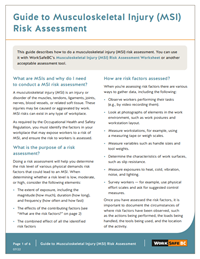Lifting & handling
Lifting, handling, or carrying objects at work can result in musculoskeletal injuries (MSIs), including sprains and strains and other injuries. The risk of injury increases when bending, twisting, heavy loads, and awkward postures are involved. Effective ergonomic controls can reduce the risk and prevent injuries.
- The risks
- Assessing the risks
- How to reduce the risks
- Resources
The risks
Injuries from lifting and handling of loads can occur in many occupations. Workers are exposed to risk when they lift, lower, or carry objects. Risk factors include:
- The weight of the load
- How close the load is to the body. A load lifted far from the body imposes more stress on the back than the same load lifted close to the body
- The size and shape of the load
- The distance the load has to be carried
- The initial height of the load and the vertical distance lifted
- Lifting in combination with twisting
- How long the load has to be carried
- The number and frequency of lifts performed
Assessing the risks
Our lift/lower calculator can be used to estimate whether a lift has a low, moderate, or high risk of injury.
Our push/pull/carry calculator can be used to estimate the suggested maximum force that can be used during pushing and pulling, and the weight that can be carried.
How to reduce the risks
When choosing the appropriate risk controls, the employer must consult with the joint health and safety committee or the worker health and safety representative. Be sure to test the risk control before fully implementing to make it work within your organization. To help identify potential risk controls, consider the following questions:
-
1
Engineering controls
Making physical modifications to facilities, equipment and processes can reduce exposure. Some questions to consider:
- Can mechanical lifting ads such as hoists, pallet jacks, carts, or conveyors be used instead of manual material handling?
- Can the load be lifted within the range of knee to waist height?
- Can the vertical distance the load has to be lifted or lowered be shortened? Options include limiting shelf height, and raising the worker.
- Can stooped or twisted positions be avoided by providing unrestricted work space, or arranging the workspace differently?
- Can the size of the load be made smaller? Options include ordering smaller containers, or having workers make two trips with smaller loads rather than one trip with a heavy load.
- Can carrying distance be shortened by changing the workflow?
-
2
Administrative controls
Changing work practices and work policies, and training workers in proper lifting and handling techniques, can limit risk of MSIs. Some questions to consider:
- Can the task design be changed? For example, changing a carrying task to a pushing or pulling task.
- Can workers be given time to rest or recover when lifting or handling loads?
- Can work demands and work pace be balanced more effectively
- Can the tasks be varied?




